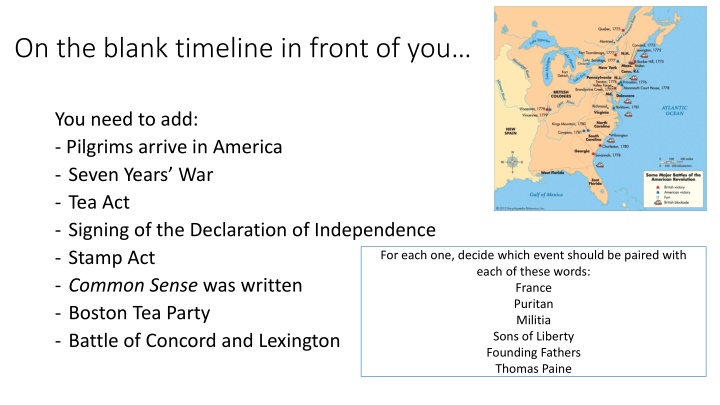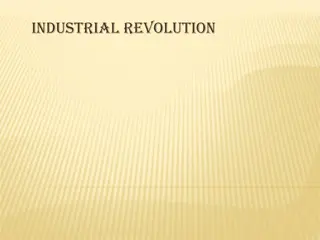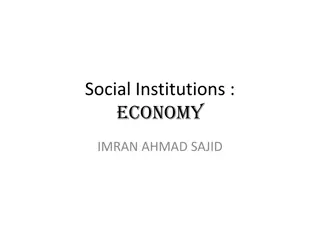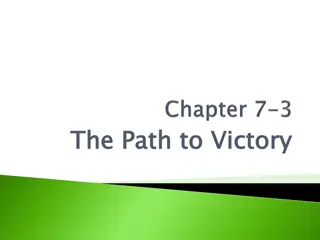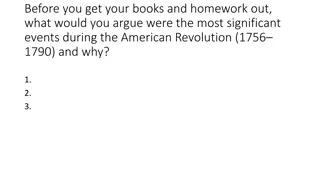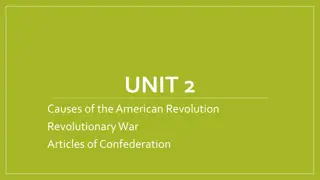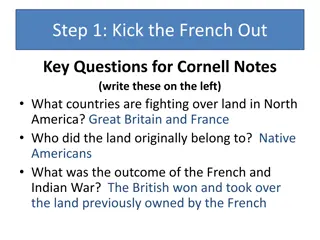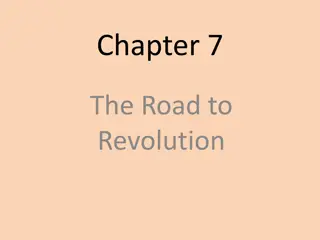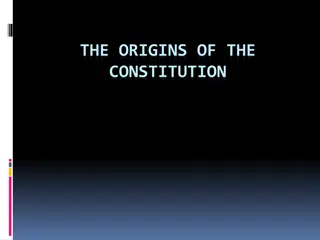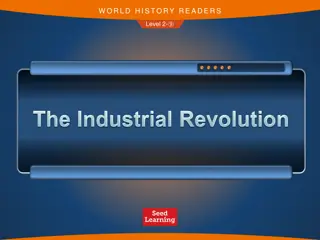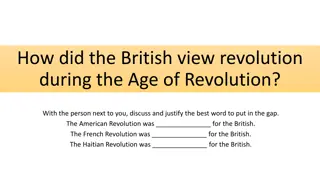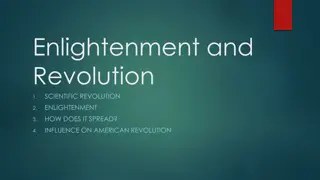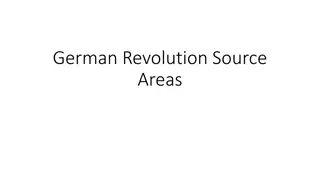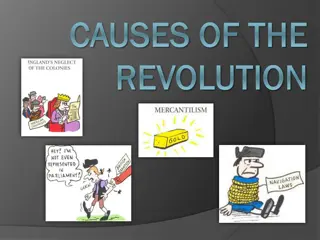The Evolution of the American Revolution
Thirteen Colonies break free, triggering an ongoing revolution against British rule. Explore key events like the Pilgrims arriving, the Declaration of Independence, battles, and pivotal figures. Discover how the revolution's aims evolved and the stages of revolution according to historian Ben Marsh.
Download Presentation

Please find below an Image/Link to download the presentation.
The content on the website is provided AS IS for your information and personal use only. It may not be sold, licensed, or shared on other websites without obtaining consent from the author.If you encounter any issues during the download, it is possible that the publisher has removed the file from their server.
You are allowed to download the files provided on this website for personal or commercial use, subject to the condition that they are used lawfully. All files are the property of their respective owners.
The content on the website is provided AS IS for your information and personal use only. It may not be sold, licensed, or shared on other websites without obtaining consent from the author.
E N D
Presentation Transcript
On the blank timeline in front of you You need to add: - Pilgrims arrive in America - Seven Years War - Tea Act - Signing of the Declaration of Independence - Stamp Act - Common Sense was written - Boston Tea Party - Battle of Concord and Lexington For each one, decide which event should be paired with each of these words: France Puritan Militia Sons of Liberty Founding Fathers Thomas Paine
On your timeline, you need to add: - Pilgrims arrive in America - Seven Years War - Tea Act - Signing of the Declaration of Independence - Stamp Act - Common Sense is written - Boston Tea Party - Battle of Concord and Lexington For each one, decide which event should be paired with each of these words: France Puritan Militia Sons of Liberty Founding Fathers Thomas Paine Can you now recall some associated words of your own? With your partner, verbally create a narrative of the events of the American Revolution up to 1776.
SHOCKWAVES AROUND THE WORLD! The Thirteen Colonies of European migrants had managed to break free from the British rule REVOLUTION! However, just because they broke free, it didn t mean the revolution was over
How far did the aims of the American Revolution change AS it was happening?
Throughout history, just because a revolution has occurred, it doesn t mean that the revolution is over. Historian Ben Marsh argues there are four key stages of a revolution: 1. Process (e.g. people are disenchanted or see an opportunity) 2. Event puts pressure on government (e.g. a riot) 3. Programme (new regime installed) 4. Myth of the revolution is created
Today we are thinking about what happens here Historian Ben Marsh argues there are four key stages of a revolution: 1. Process (e.g. people are disenchanted or see an opportunity) 2. Event puts pressure on government (e.g. a riot) 3. Programme (new regime installed) 4. Myth of the revolution is created Between the new regime and the myth being created: revolutions are disputed, people become suspicious of each other, there is resistance against the revolution
What happened during the REST of the American revolution, 1776 1790? Reading the information sheet together be ready for questions! 1776: The Thirteen Colonies declared independence 1763 1790 The bit we are looking at today. The bit we have looked at
With all this information in mind, we are going to focus on the framers of the American Constitution: George Washington Thomas Jefferson James Madison Alexander Hamilton Benjamin Franklin John Jay John Adams Your task is to answer the following questions using the character cards. Writing the surnames will suffice.
1. 2. 3. 4. Who was a plantation owner? Who came from a big city? Who wanted strong central government? What were the different arguments for why strong central government was needed? Who wanted lots of individual liberties? Who argued for freedom to include slaves as well? Who wanted the states to have lots of power? Who really wanted the other states to accept the Constitution? Is there anyone who wouldn t have seen the Constitution as a bit of a compromise? 10. Why do you think Washington was chosen to preside over the Constitutional Convention? 11. Can you summarise each person s views on the revolution between 1776 and 1788? 12. Where can you find evidence of anyone s views changing on what the revolution was about after 1776? 5. 6. 7. 8. 9.
1. 2. 3. 4. Who was a plantation owner? Madison, Jefferson, Washington Who came from a big city? Hamilton, Jay, Adams, Franklin Who wanted strong central government? Madison, Jay, Hamilton, Washington What were the different arguments for why strong central government was needed? Money and supplies in times of war, less need to borrow from other countries, allows a strong foreign policy. Who wanted lots of individual liberties? Jefferson (also Madison ,when drawing up Bill of Rights) Who argued for freedom to include slaves as well? Franklin, Jay Who wanted the states to have lots of power? Jefferson Who really wanted the other states to accept the Constitution? Madison, Hamilton, Jay Is there anyone who wouldn t have seen the Constitution as a bit of a compromise? No 10. Why do you think Washington was chosen to preside over the Constitutional Convention? He wanted change but also saw the views of the plantation owners 11. Can you summarise each person s views on the revolution between 1776 and 1788? 12. Where can you find evidence of anyone s views changing on what the revolution was about after 1776? Washington increasingly strong central because of war with British Jay increasingly strong central because of war with British, increasingly abolitionist Hamilton increasingly strong central because of war with British Franklin increasingly abolitionist Jefferson increasingly supportive of individual liberties 5. 6. 7. 8. 9.
Time to discuss the BIG question How far did the aims of the American Revolution change AS it was happening? 1776 1790 Everyone s aims completely changed from 1776 1790 Stayed the same from 1776 1790
Bringing EVERYTHING together to stretch yourselves How far did the aims of the American Revolution change AS it was happening? 1763 1790 Everyone s aims completely changed from 1763 1790 Stayed the same from 1763 1790
For next time 1. Complete a detailed timeline of the American Revolution using everything you have learned so far. Put the events on the timeline you were given at the start of the lesson. 2. Use your homework from last lesson to try to add at least three new things to your timeline in a different colour.
